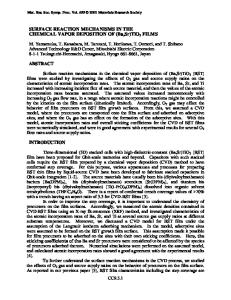Conduction and Microwave Loss Mechanisms in Ba 0.25 Sr 0.75 TiO 3 Films
- PDF / 233,557 Bytes
- 6 Pages / 612 x 792 pts (letter) Page_size
- 102 Downloads / 376 Views
C8.7.1
Conduction and Microwave Loss Mechanisms in Ba0.25Sr0.75TiO3 Films Andrei Vorobiev1,2, Par Rundqvist1, Khaled Khamchane1, and Spartak Gevorgian1,3 1 Department of Microtechnology and Nanoscience, Chalmers University of Technology, SE41296 Gothenburg, Sweden 2 Institute for Physics of Microstructures RAS, N. Novgorod, GSP-105, 603600, Russia 3 Microwave and High Speed Electronics Research Center, Ericsson AB, 431 84 Moelndal, Sweden
ABSTRACT Silicon integrated parallel-plate Ba0.25Sr0.75TiO3 (BST) thin film varactors with Au bottom electrode have been prepared and characterized at dc and microwave frequencies. In the frequency range 0.045-45 GHz the varactors reveal extremely low loss tangent values (less than 0.025). However, this is still several times higher than loss in single crystal indicating occurrence of the extrinsic loss mechanisms. The analysis of BST film loss tangent and permittivity, depending on frequency and applied dc field, allow to attribute the dielectric loss to the charged defects. The dc current through varactor is found to be controlled by Poole-Frenkel mechanism associated with field enhanced thermal excitation of charge carriers from internal traps. It is assumed that charged defects and internal traps are the same type of BST film microstructure imperfection and possibly ascribed to be oxygen vacancies. The knowledge of the extrinsic loss mechanism and corresponding microstructure defects allows to optimize the deposition and/or anneal process and further improve the varactor performance.
INTRODUCTION BaxSr1-xTiO3 (BST) based thin film varactors have been intensively investigated as a voltage tunable element for various microwave devices [1,2]. For large scale industrial applications integration of parallel-plate varactor with silicon substrate is most promising. Recently it was shown that total losses of these varactors can be reduced sufficiently by using high conductive Au bottom electrode allowing to reduce the metal loss [3,4]. However, loss tangent of varactors remains approximately 5 times higher than Ba0.27Sr0.73TiO3 single crystal at 10 GHz and room temperature [5]. This indicates that along with fundamental phonon loss mechanism there are extrinsic loss mechanisms coupling the microwave field with defects. The extrinsic microwave loss mechanisms in the ferroelectrics are summarized by Tagantsev [6] and Vendik [7,8]: (i) loss owing to charged defects, (ii) universal relaxation law mechanism, (iii) quasi-Debye contribution induced by random –field defects. Obviously, a certain type of extrinsic loss mechanism is related to corresponding microstructure imperfection. Identification of the predominant loss mechanism would allow to improve the ferroelectric (FE) film microstructure and reduce the microwave loss down to fundamental value. A way to detect certain types of microstructure defects is to analyze the dc current through FE film. A number of publications were devoted to this subject [9,10,11]. The most probable mechanisms controlling the nonlinear dc current through p
Data Loading...











